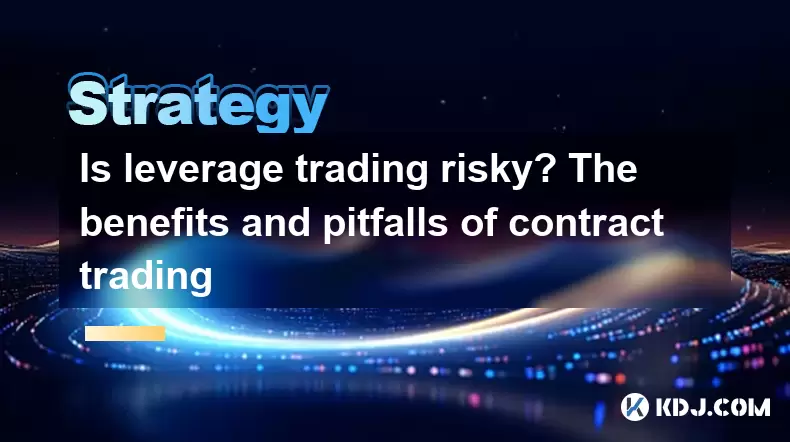-
 bitcoin
bitcoin $118548.520763 USD
3.67% -
 ethereum
ethereum $4352.564943 USD
4.79% -
 xrp
xrp $2.964058 USD
4.22% -
 tether
tether $1.000565 USD
0.05% -
 bnb
bnb $1028.372955 USD
1.46% -
 solana
solana $221.373507 USD
6.00% -
 usd-coin
usd-coin $0.999933 USD
0.02% -
 dogecoin
dogecoin $0.248633 USD
6.85% -
 tron
tron $0.341444 USD
2.38% -
 cardano
cardano $0.852946 USD
5.82% -
 hyperliquid
hyperliquid $47.869306 USD
6.15% -
 chainlink
chainlink $22.561476 USD
6.01% -
 ethena-usde
ethena-usde $1.001258 USD
0.05% -
 avalanche
avalanche $30.660000 USD
2.06% -
 stellar
stellar $0.400917 USD
9.76%
Is leverage trading risky? The benefits and pitfalls of contract trading
Leverage trading offers potential for higher returns but comes with significant risks like amplified losses and margin calls, requiring careful risk management.
Jun 03, 2025 at 11:29 pm

Is leverage trading risky? The benefits and pitfalls of contract trading
Leverage trading in the cryptocurrency market, particularly through contract trading, has become increasingly popular among traders looking to amplify their potential returns. However, the question of whether leverage trading is risky is one that requires a nuanced understanding of both its benefits and its pitfalls. In this article, we will explore the intricacies of leverage trading, focusing on contract trading, to provide a comprehensive analysis of its risks and rewards.
Understanding Leverage and Contract Trading
Leverage trading involves borrowing funds to increase the size of a trade, thereby magnifying potential profits. In the context of cryptocurrency, contract trading typically refers to futures or perpetual contracts, which are agreements to buy or sell an asset at a future date for a price determined today. These contracts allow traders to speculate on the price movements of cryptocurrencies without owning the underlying assets.
The concept of leverage is central to contract trading. For example, with a leverage of 10x, a trader can open a position worth $10,000 with just $1,000 of their own capital. This can lead to significant profits if the market moves in the trader's favor, but it also amplifies losses if the market moves against them.
Benefits of Leverage Trading
One of the primary benefits of leverage trading is the potential for higher returns. By using leverage, traders can control larger positions than they could with their own capital alone. For instance, if a trader uses 10x leverage and the price of the asset increases by 10%, their profit would be 100% of their initial investment, rather than just 10%.
Another advantage is the ability to profit from both rising and falling markets. With contract trading, traders can take both long and short positions, allowing them to capitalize on market volatility. This flexibility can be particularly beneficial in the highly volatile cryptocurrency market.
Additionally, leverage trading provides access to a broader range of trading strategies. Traders can use various techniques, such as hedging and arbitrage, to manage risk and enhance their trading performance. This can be particularly appealing to experienced traders looking to diversify their portfolios.
Pitfalls of Leverage Trading
Despite its potential benefits, leverage trading comes with significant risks. The most obvious pitfall is the amplification of losses. If the market moves against a leveraged position, the losses can quickly exceed the initial investment. For example, if a trader uses 10x leverage and the price of the asset falls by 10%, they would lose their entire investment.
Another major risk is the possibility of a margin call. When trading with leverage, traders must maintain a minimum amount of capital in their account, known as the margin. If the value of their position falls below this level, they may be required to deposit additional funds or face liquidation of their position. This can happen rapidly in volatile markets, leading to significant losses.
The complexity of contract trading can also be a pitfall. Futures and perpetual contracts involve intricate mechanics, such as funding rates and settlement processes, which can be challenging for inexperienced traders to navigate. Misunderstanding these elements can lead to unexpected losses.
Risk Management in Leverage Trading
Given the risks associated with leverage trading, effective risk management is crucial. One key strategy is setting stop-loss orders, which automatically close a position when it reaches a certain loss threshold. This can help limit potential losses and protect the trader's capital.
Position sizing is another important aspect of risk management. Traders should carefully consider the size of their leveraged positions relative to their total capital. A common rule of thumb is to risk no more than 1-2% of their account balance on any single trade.
Diversification can also help mitigate risk. By spreading their investments across different assets and trading strategies, traders can reduce their exposure to any single market movement. This can be particularly beneficial in the volatile cryptocurrency market.
The Psychological Aspect of Leverage Trading
The psychological impact of leverage trading cannot be overlooked. The potential for rapid gains and losses can lead to heightened emotions, such as greed and fear, which can cloud judgment and lead to poor decision-making. Traders must be aware of these psychological factors and develop strategies to manage them.
One effective approach is to maintain a trading journal, documenting each trade and the reasoning behind it. This can help traders reflect on their decisions and identify patterns in their behavior. Additionally, setting clear trading goals and sticking to a disciplined trading plan can help mitigate the emotional impact of leverage trading.
Seeking support from a community of fellow traders can also be beneficial. Sharing experiences and learning from others can provide valuable insights and help traders stay grounded during periods of market volatility.
Practical Steps for Engaging in Contract Trading
For those interested in engaging in contract trading, here are some practical steps to get started:
- Choose a reputable exchange: Select a cryptocurrency exchange that offers futures or perpetual contracts and has a strong track record of security and reliability.
- Open an account: Register for an account on the chosen exchange, completing any necessary verification processes.
- Fund your account: Deposit funds into your trading account, ensuring you have enough capital to cover potential margin requirements.
- Understand the contract specifications: Familiarize yourself with the details of the futures or perpetual contracts you plan to trade, including the underlying asset, contract size, and settlement process.
- Set up a trading strategy: Develop a clear trading strategy, including entry and exit points, position sizing, and risk management rules.
- Start with small positions: Begin with small, manageable positions to gain experience and build confidence before increasing your exposure.
- Monitor your positions: Keep a close eye on your open positions, adjusting your strategy as needed based on market conditions.
Frequently Asked Questions
Q: Can I trade leverage contracts with any amount of money?A: While it is technically possible to trade leverage contracts with small amounts of money, it is generally not advisable. Trading with insufficient capital can lead to rapid margin calls and liquidation. It is important to have enough capital to cover potential losses and meet margin requirements.
Q: How does the funding rate affect my leverage trading?A: The funding rate is a mechanism used in perpetual contracts to ensure the contract price stays close to the underlying asset's price. Traders who hold long positions pay a funding fee to those holding short positions if the funding rate is positive, and vice versa if it is negative. Understanding and monitoring the funding rate is crucial for managing the costs associated with holding leveraged positions.
Q: Is it possible to make a living from leverage trading?A: While some traders do make a living from leverage trading, it is a challenging and risky endeavor. Success in leverage trading requires a deep understanding of the markets, a robust trading strategy, and disciplined risk management. It is not a guaranteed path to financial success and should be approached with caution.
Q: What are the differences between futures and perpetual contracts?A: Futures contracts have a set expiration date, at which point they must be settled or rolled over into a new contract. Perpetual contracts, on the other hand, do not expire and can be held indefinitely. This makes perpetual contracts more flexible but also introduces additional complexities, such as the funding rate mechanism.
Disclaimer:info@kdj.com
The information provided is not trading advice. kdj.com does not assume any responsibility for any investments made based on the information provided in this article. Cryptocurrencies are highly volatile and it is highly recommended that you invest with caution after thorough research!
If you believe that the content used on this website infringes your copyright, please contact us immediately (info@kdj.com) and we will delete it promptly.
- BlockDAG, DOGE, HYPE Sponsorship: Crypto Trends Shaping 2025
- 2025-10-01 00:25:13
- Deutsche Börse and Circle: A StableCoin Adoption Powerhouse in Europe
- 2025-10-01 00:25:13
- BlockDAG's Presale Buzz: Is It the Crypto to Watch in October 2025?
- 2025-10-01 00:30:13
- Bitcoin, Crypto, and IQ: When Genius Meets Digital Gold?
- 2025-10-01 00:30:13
- Stablecoins, American Innovation, and Wallet Tokens: The Next Frontier
- 2025-10-01 00:35:12
- NBU, Coins, and Crypto in Ukraine: A New Yorker's Take
- 2025-10-01 00:45:14
Related knowledge

Practical parameter settings for a Bitcoin multi-timeframe moving average system
Sep 18,2025 at 10:54pm
Optimizing Timeframe Combinations for Bitcoin Trading1. Selecting appropriate timeframes is crucial when building a multi-timeframe moving average sys...

How can I filter out false breakouts in Dogecoin high-frequency trading?
Sep 22,2025 at 01:00am
Understanding False Breakouts in Dogecoin Trading1. A false breakout occurs when Dogecoin's price appears to move beyond a defined support or resistan...

Techniques for identifying tops and bottoms in the Bitcoin on-chain NVT model
Sep 20,2025 at 07:54pm
Understanding the NVT Model in Bitcoin Analysis1. The Network Value to Transactions (NVT) ratio is often described as the 'P/E ratio' of the cryptocur...

What does the surge in open interest in Bitcoincoin futures mean?
Sep 20,2025 at 11:18pm
Understanding the Surge in Dogecoin Futures Open Interest1. A surge in open interest within Dogecoin futures indicates a growing number of active cont...

How can I use the Ethereum USDT premium to gauge market sentiment?
Sep 18,2025 at 11:55pm
Understanding the Ethereum USDT Premium1. The Ethereum USDT premium refers to the price difference between USDT (Tether) traded on Ethereum-based plat...

What should I do if Ethereum staking yields decline?
Sep 20,2025 at 06:18am
Understanding the Causes Behind Declining Ethereum Staking Yields1. The Ethereum network transitioned to a proof-of-stake consensus mechanism with the...

Practical parameter settings for a Bitcoin multi-timeframe moving average system
Sep 18,2025 at 10:54pm
Optimizing Timeframe Combinations for Bitcoin Trading1. Selecting appropriate timeframes is crucial when building a multi-timeframe moving average sys...

How can I filter out false breakouts in Dogecoin high-frequency trading?
Sep 22,2025 at 01:00am
Understanding False Breakouts in Dogecoin Trading1. A false breakout occurs when Dogecoin's price appears to move beyond a defined support or resistan...

Techniques for identifying tops and bottoms in the Bitcoin on-chain NVT model
Sep 20,2025 at 07:54pm
Understanding the NVT Model in Bitcoin Analysis1. The Network Value to Transactions (NVT) ratio is often described as the 'P/E ratio' of the cryptocur...

What does the surge in open interest in Bitcoincoin futures mean?
Sep 20,2025 at 11:18pm
Understanding the Surge in Dogecoin Futures Open Interest1. A surge in open interest within Dogecoin futures indicates a growing number of active cont...

How can I use the Ethereum USDT premium to gauge market sentiment?
Sep 18,2025 at 11:55pm
Understanding the Ethereum USDT Premium1. The Ethereum USDT premium refers to the price difference between USDT (Tether) traded on Ethereum-based plat...

What should I do if Ethereum staking yields decline?
Sep 20,2025 at 06:18am
Understanding the Causes Behind Declining Ethereum Staking Yields1. The Ethereum network transitioned to a proof-of-stake consensus mechanism with the...
See all articles










































































